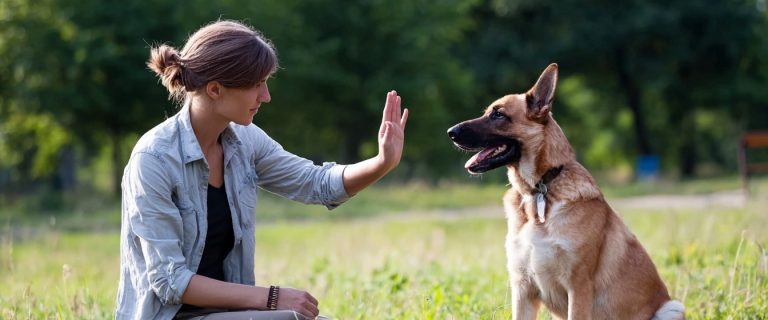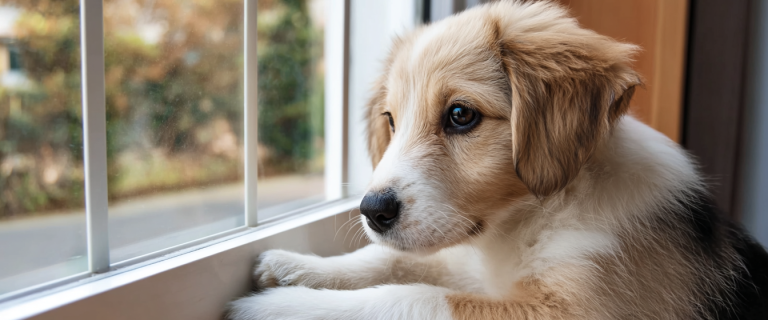Raising a puppy and a child together is not an easy task, and you’ll often wonder how best to train the child not to get bitten by the puppy.
Staying vigilant all the time and training the puppy is not enough because children need to learn how to be kind and respectful to animals.
So, today we’re going to talk about how best you can train your child to behave around puppies.
Keep on reading to get some awesome tips!

How to train my child not to get bitten by a new puppy?
Raising a puppy is a task that requires a lot of efforts and time on your hands, and it’s not a job for a child.
That’s why I would recommend that you get a puppy when you’re certain that you can handle both the child and the puppy.
When you’re ready, here are six tips to help you train your child to interact safely with a puppy.
#1 Establish the rules
The first thing you should do if you are thinking about bringing a puppy home is to sit and have a talk with your child.
No matter how small your child is, you should try to explain to him how to behave around the puppy:
- No tail or ears pulling
- No squeezing or hugging
- No running towards the dog or sudden movements
- Leave the dog alone when he is playing or in pain
#2 Supervise and repeat the rules
As you already know, children are children. When you tell them not to do anything, they want to do it even more so that they can see what will happen.
So, it’s very likely that your child will ignore your warnings or any boundaries you have set. That’s why you have to be consistent and repeat them as often as necessary.
You should also avoid leaving the child and the puppy unsupervised. As much as you trust your child and puppy to behave, you never know what might happen.
Your child might decide to do something stupid, or the puppy might be in pain. That’s how a lot of accidents happen.
What’s more, puppies tend to bite when they start teething. During that period, they will put everything possible in their mouth to relieve the pain from the emerging teeth.
So, it’s even more important that you supervise and interfere when you notice inappropriate chewing.
#3 Set an example
Children are copies of their parents. If they see that you are unfair to the puppy, that you scold or yell at him or that you don’t pay him enough attention, your child will follow suit.
To train your child not to get bitten by a new puppy, teach him to be kind to other children and pets by giving the best possible example.
Show your children that pets are part of the family and that they should always be gentle with their pets and considerate of their needs.
#4 Explain the warning signs
Puppies run, chase, bark, growl, and bite when they play. That’s completely normal behavior, but it sometimes startles inexperienced puppy parents.
Of course, it’s natural to be worried when you see that the puppy is barking or growling at your child.
But you have to learn to distinguish between puppy play and genuine aggression and teach your child to do the same.
Usually, the signs that a puppy is getting aggressive and might bite are:
- Deep growling, which is different from “play” growling
- Showing teeth
- Rigid posture
- Fixed gaze
- Rapidly moving tail
However, you should keep something in mind. Sometimes the signs are subtle and might be confusing even for an adult.
What’s more, the puppy might get overly excited during play time and bite accidentally.
#5 Discourage aggressive play
When you notice that your child and puppy are engaged in rough play, step in. Use a toy to distract the puppy and redirect its attention to something more appropriate.
Do not allow things to escalate, or both child and puppy will end up hurting.
If the puppy bites the child, no matter the circumstances, do not punish the animal. The puppy won’t understand why you’re doing it.
Instead, the puppy might start to fear the presence of the child because of your anger and punishment.
#6 Do not tolerate mistreatment
It’s possible that your child will do something to hurt the puppy accidentally, and it will retaliate by biting. That’s one way for the child to learn that he shouldn’t do certain things.
Keep in mind that in some situations, the bite is more educational than any words.
However, if you notice that your children are treating the puppy badly on purpose, you have to take measures.
Talk to the child and make him understand that his actions are inappropriate. Do not turn a blind eye or you risk the problem to escalate in the future.
Children and puppies can coexist in harmony as long as you train your child to behave properly and establish boundaries.
Remember that the puppy also needs extensive training so that it knows what’s allowed and what’s not.
What are your thoughts on the subjects? How best can you train a child not to get bitten by a new puppy? Tell us what you think in the comment section.
Author
-

I’ve grown up surrounded by animals – dogs, cats, cows, goats, sheep, and horses and that has shaped me into what I am today – a crazy cat lady who always has a place for one more cat (or a dog). I’ve got two female cats – Kitty and Roni, and two tomcats – Blacky and Shaggy, but I also feed my neighbors’ cats when they come for a visit. I just can’t say no to them.
View all posts



